Introduction
The statue of Berlioz in pictures
This page is also available in French
![]()
Berlioz had a rather low opinion of the musical capabilities of Grenoble in his own time, and his infrequent visits to that city were made most of the time for personal and family reasons. He would therefore have been pleasantly surprised to see how, many years later, Grenoble eventually celebrated the centenary of his birth in 1903 in style. A Centenary Committee, presided by M. de Beylié, was formed whose remit was to erect a statue of Berlioz, to organise concerts of his major works, and to publish a commemorative centenary book (Preface, Le Livre d’Or du Centenaire d’Hector Berlioz).
The 100th anniversary of Berlioz’s birth fell on 11 December 1903, but the authorities wanted to bring the inauguration ceremony forward to August, to take advantage of the good weather in summer, attract more visitors and steal a march on Paris, where the centenary celebrations only took place in December. Exactly 35 years after the inauguration of Napoleon’s statue in Grenoble which Berlioz had attended, the statue of the composer, made by the Grenoble sculptor Urbain Basset, was erected in Place Victor Hugo on 15 August 1903, as part of the Berlioz centenary celebrations in the city.
There are several accounts of the celebrations, which differ in some important details. Le Monde Illustré, published in Paris, gave a brief report of part of this ceremony in its issue of 22 August 1903, and Julien Tiersot, who witnessed the event, briefly wrote about it in his 1904 book on Berlioz. There is also a more detailed account by Adolphe Jullien, who attended the celebrations in Grenoble (Journal des Débats, 30 August 1903). These accounts give a dramatic account of the ceremony itself; according to them, the unveiling of the statue was disrupted while already in progress by a sudden storm which drenched the participants. This is Tiersot’s short account in his 1904 book:
On 15 August 1903 Grenoble, the capital of his native province, celebrated the centenary of Berlioz’s birth with a festival. At the precise moment when the inauguration of his statue was due to take place a tremendous hurricane came down from the Alps and shook the air. It was in the midst of lightning and peals of thunder that the image of the greatest French musician of modern times was revealed to the eyes of his compatriots.
In the evening the stars shone in the sky that was now clear, and the next morning the sun rose radiantly.
Everyone understood that the caprices of the weather were a faithful symbol of Berlioz’s destiny.
(Julien Tiersot, 1904, p. 207)
The account in Le Monde Illustré is even more dramatic: according to it, a deluge of rain inundated the streets and squares at the critical moment, dispersing the official cortège and the guests, and emptying the space around the monument. However, M. de Beylié, the president of the celebrations committee, courageously continued with the ceremony which had to be curtailed, ordered the statue to be unveiled, and then made a short speech.
Against these stands the much more detailed account by Felix Weingartner, the celebrated Kapellmeister of Munich, who was invited to attend the whole of the celebrations in Grenoble from 15 to 17 August and was an active participant in them. His account, which is available on this site in the German original, and in translations in English and French (both by Michel Austin), is factual and has every chance of being more accurate. According to him, the ceremony first had to be postponed from the morning of the 15th to the afternoon because of a thunderstorm during the night which continued into the morning. The weather cleared in the afternoon, but as the ceremony was about to begin another storm broke out unexpectedly, and it was only after it had cleared that the ceremony could take place, though it had to be curtailed as there was a risk that the bad weather might return. At the end of the ceremony Weingartner was able to deposit on the base of the statue a silver-gilt wreath adorned with a ribbon bearing the colours of Germany, with the inscription in German: Dem unsterblichen Meister, Grenoble 15 August 1903, Felix Weingartner [To the immortal Master, Grenoble 15 August 1903, Felix Weingartner].
In his book cited above, Tiersot poignantly says that ‘We can believe that this peaceful monument will be lasting’. But this was not to be. The bronze statue was dismantled then melted down by the Germans at some time after September 1943 when they occupied the city in the course of the 1939-1945 war.
The new statue of Berlioz which is now in the Place Victor Hugo, was erected in 1953 on the exact location of the original one. It is the work of the sculptor Claude Grange (or Grangé), who was born in Vienne on 23 September 1883 and died in Paris on 22 September 1971. A plaster cast of Grangé’s statue of Berlioz had already been presented at the 1933 Salon, held at the Grand Palais in Paris; it is now in the Hector Berlioz Museum at La Côte-Saint-André. The new statue was inaugurated towards the end of November 1953, in the presence of numerous public figures such as the Minister of Education André Marie and the Danish ambassador, and a performance of the Hungarian March was given by the municipal brass band of Grenoble. The inauguration was related in the paper Le Dauphiné Libéré on 30 November 1953. (We are most grateful to M. Antoine Troncy, Assistant de Conservation at the Hector Berlioz Museum, for providing us with the information regarding the fate of the original statue and its modern replacement.)
The two concerts organised by the Centenary Committee were given at the Théâtre municipal de Grenoble on 16 and 17 August. At the first concert La Damnation de Faust was conducted by Léon Jehin. In the first half of the concert on 17 August, Georges Marty conducted excerpts from Roméo et Juliette, Harold en Italie, Béatrice et Bénédict, and the overture le Carnaval romain. In the interval, Julien Tiersot gave a talk on Berlioz which is reproduced on this site, and M. Bréant recited a poem by Camille Saint-Saëns, hitherto unpublished (the poem was later published in the journal Musica in 1908 and has been reproduced on this site). In the second half of the concert Felix Weingartner conducted the Symphonie fantastique. The concerts were commented on by music critics in France and abroad. After the second concert Weingartner travelled by car during the night to La Côte Saint-André to present the wreath to the house where Berlioz was born. In his narrative on the centenary celebrations of Grenoble he gives a vivid account of his journey to La Côte and overnight stay there.
The commemorative book, entitled Le Livre d’Or du Centenaire d’Hector Berlioz, which included the speech of Julien Tiersot, was published simultaneously in Grenoble by Allier Frères and in Paris by Georges Petit – the Preface is dated June 1906. (The table of contents of this book is reproduced elsewhere on this site.) Details of the concert programmes, reviews published in various newspapers, and the complete text of the speeches which were to be delivered at the inauguration of the statue are reproduced in the book as well (pp. 3-74).
On the initiative of the Centenary Committee an official set of postcards was published, each of which represented different stages of Berlioz’s life and beyond, using contemporary 19th century engravings published in Adolphe Jullien, Hector Berlioz, sa vie et ses œuvres (Paris, 1888). Ten of these cards are in our collection.
In addition to the above, a musical competition was held on 14-17 August 1903 in Grenoble and a medal, in gold, silver and bronze, was issued to commemorate the centenary of Berlioz’s birth.
![]()
All the modern photos reproduced on this page were taken by Michel Austin in September 2008 and August 2009; other pictures have been scanned from postcards and other publications in our own collection. © Monir Tayeb and Michel Austin. All rights of reproduction reserved.
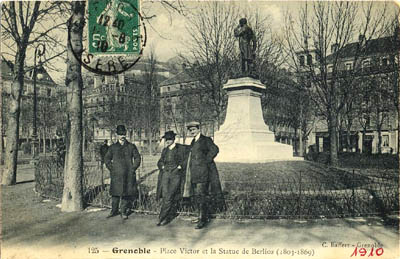
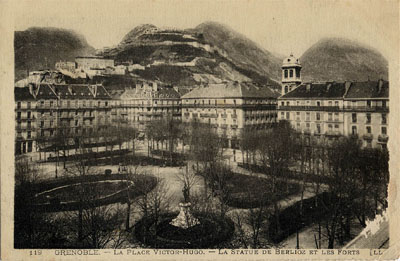
The old Bastille and Rabot fortifications on the hill at the back overlook the Place; the Saint-Eynard is on the right of the picture in the distance.

Undated.
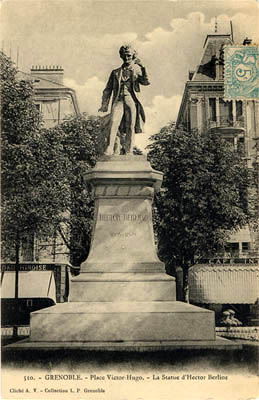
The above postcard was posted in 1907.
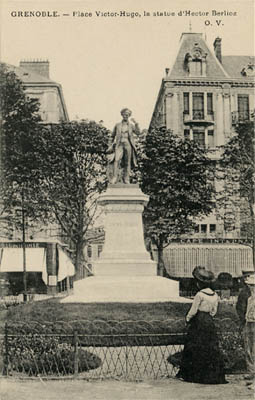

The above postcard was published around 1910.
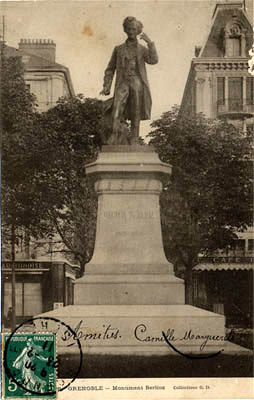
The above postcard was posted in 1911.
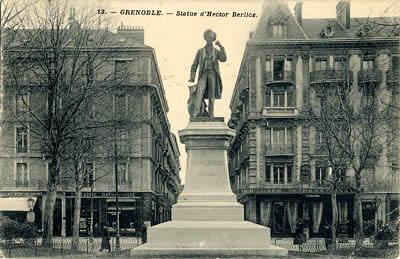
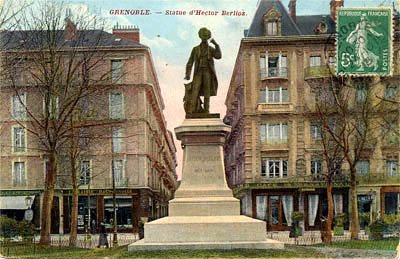
The above two postcards were posted in 1913.
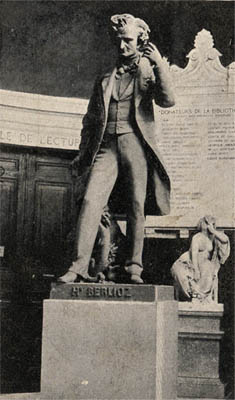
This 1903 postcard shows an identical statue inside a building; it was written and posted in Grenoble on 15 April 1903. The card is a Berlioz centenary souvenir. We have not been able to identify the building which housed the statue at the time this card was published. Judging by the title of the list to the right of the statue, DONATEURS DE LA BIBLIOTHE[QUE] and the words on the entrance to the room to the left, [SAL]LE DE LECTUR[E], it is probably the old
building which at the time housed the Musée-Bibliothèque de Grenoble [Museum-Library of Grenoble]. We have not been able to establish whether this is the same statue that was installed and inaugurated 4 months later on 15 August of the same year at the Place Victor Hugo.![]()
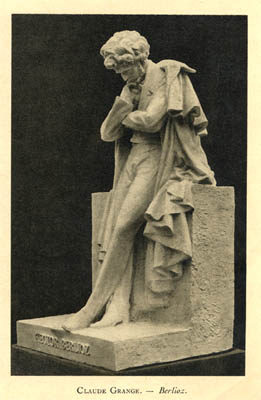
This picture appeared in L’Illustration of 20th May 1933, No. 4707. We are most grateful to M. Jean-Claude Luc for generously giving us an original copy of this issue.
A bronze version of the statue, made also by Claude Grange in 1952, is in the Hector Berlioz Museum. (see below)![]()
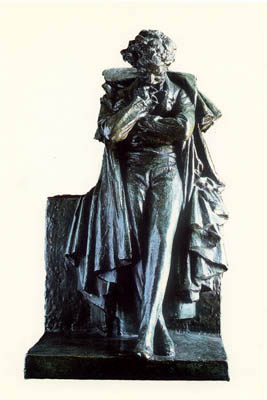
The above postcard was published by the Hector Berlioz Museum.

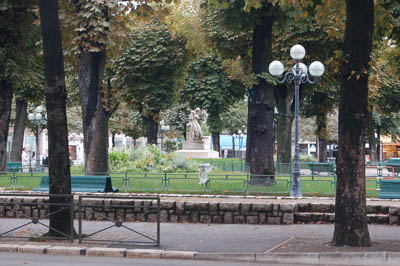
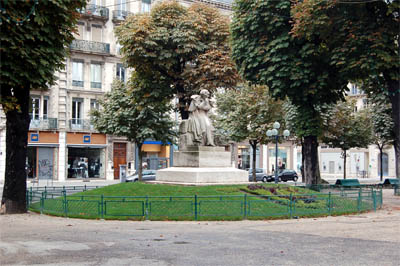
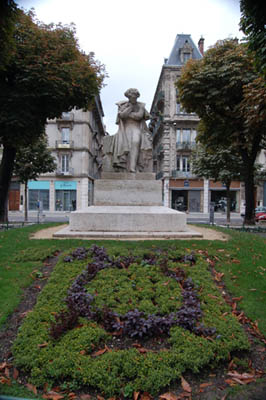

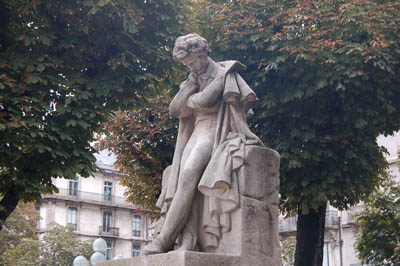
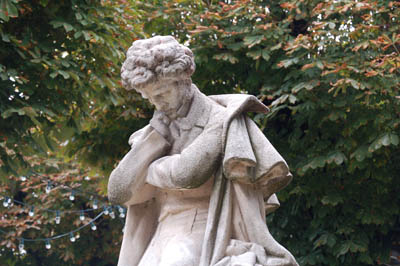

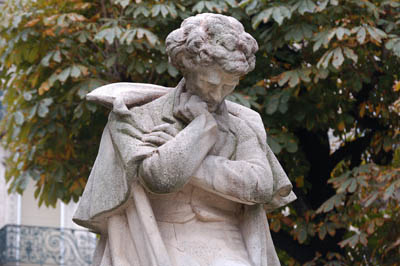


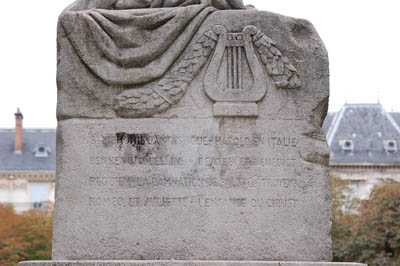
The inscription reads:
SYMPHONIE FANTASTIQUE – HAROLD EN ITALIE
BENVENUTO CELLINI – BEATRICE ET BENEDICT
REQUIEM – LA DAMNATION DE FAUST – LES TROYENS
ROMEO ET JULIETTE – L’ENFANCE DU CHRIST![]()
![]()
The Hector Berlioz Website was created by Monir Tayeb and Michel Austin on 18 July 1997;
Berlioz in Grenoble page created on 11 December 2008; this page updated on
6 December 2009, 11 December 2012, 15 January 2013, and 1 February 2019. Revised on 1 July 2023.
© Monir Tayeb and Michel Austin for all the pictures and information on this page.
Copyright notice: The texts, photos, images and musical scores on all pages of this site are covered by UK Law and International Law. All rights of publication or reproduction of this material in any form, including Web page use, are reserved. Their use without our explicit permission is illegal.